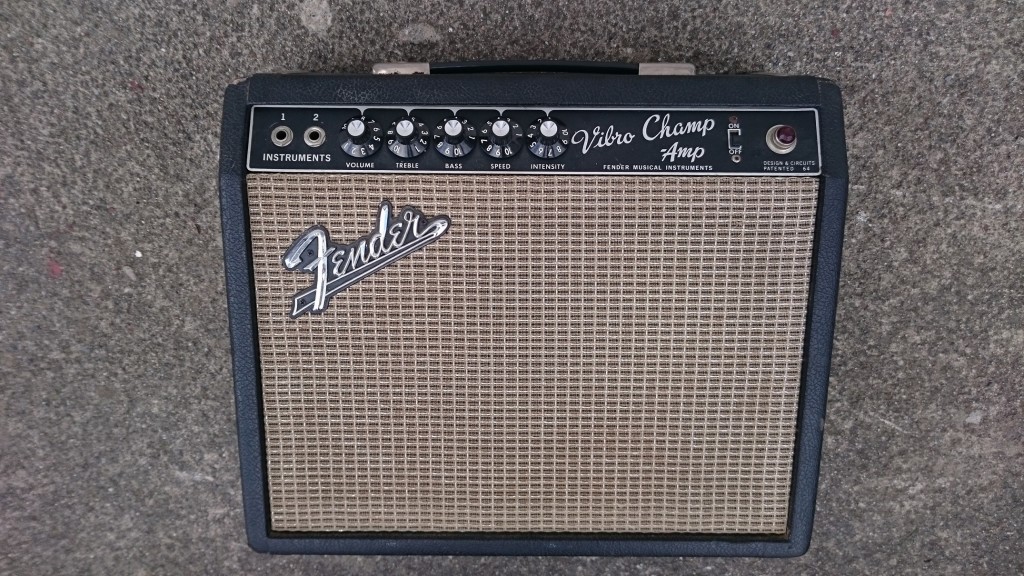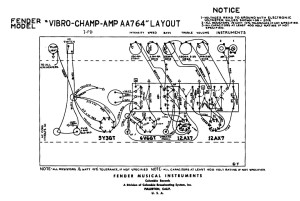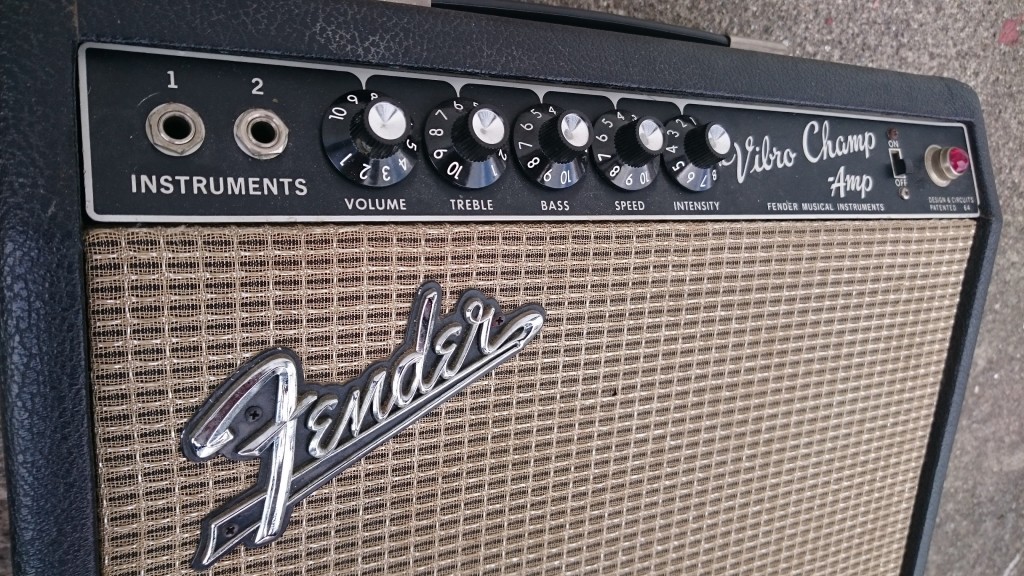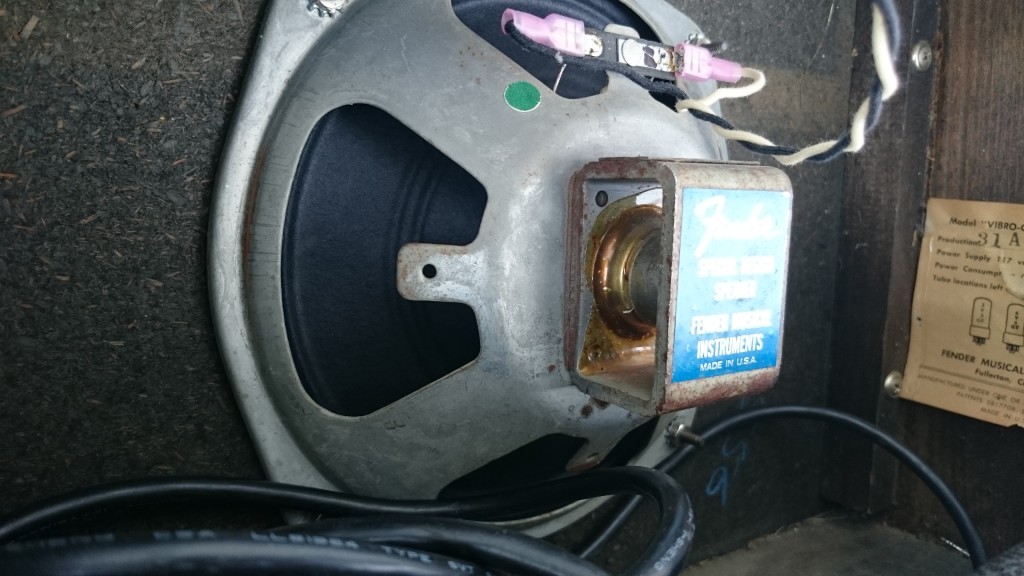Production years:
- 1964 – 1967 blackface Vibro Champ AA764
- 1964 – 1967 blackface Champ AA764
- 1968 – 1982 silverface Vibro Champ AA764
- 1968 – 1982 silverface Champ AA764
Schematic and tube layout
AA764 tube layout (seen from behind, V1 is to the right side)
- V1 12ax7 = 1/2 Preamp + 1/2 Phase inverter
- V2 12ax7 = Vibrato (only on the Vibro Champ model)
- V3 6V6GT = Power tube
- V4 5Y3GT = Rectifier tube
Summary
You might wonder how a 10kg, 6 watt combo amp without reverb (!) and with a tiny 8 inch speaker can be of any value to a guitar player or musician. We did as well before we got our Blackface Fender Vibro Champ in 2005. As we’ve now enjoyed this amp for over ten years, bringing it with us on every family vacation where we drive by car, it’s time we explain how it works and what it can do. Then you’ll have to decide yourself if it’s worth trying out or not.
The Blackface Champ and Vibro Champ (with tremolo) was introduced in 1964 after its predecessor, the narrow panel tweed Champ, had been produced nine long years at Fender since 1955. The blackface model continued the 1×8″ combo design and the single ended 6V6 power amp, class A. It was still the smallest kid in the Fender amp family. Unlike most other amp models Fender kept the circuit almost unchanged during the silverface era. All resistor and capcitor values are the same between the two eras and the only practical difference is the regular blackface and silverface differences; cabinet + baffle construction, chocolate drop caps, plastic insulated wires. This means that you’ll get good bang for the buck with a silverface amp. Also, smaller and lighter amps like Champs and Princetons have stood the test of time much better than bigger amps. The wooden cabinet and baffle board does not have to carry those heavy speakers and transformers.
Given its small size and low output the Champ is mostly used as a practise amp at home or in studios. 6 watts from a 8″ combo amp is simply not enough to deliver distinct clean tones on stages and in larger practise rooms together with a drummer. But there are many players out there who don’t need clean tone and, in their mission of rock’n roll, have modified the Champ with a switch that disengages the tone stack to get a loud and hugely distorted Marshall/Tweed tone. Even without a huge bottom end there are enough mids and screaming highs to cut through in most bands.
Personally we have not modified the tone stack on these amps since we are clean tone hunters. When we have needed more volume we have turned to bigger Fender amps or we’ve used extension cabinets with efficient and punchy speakers. 6 slightly distorted watts through a 12″ or 15″ speaker is loud enough for most players.
The video below demonstrates a 1965 Vibro Champ
The difference between the Champ and the Vibro Champ is the tremolo and not the vibrato. As you should know neither of them have vibrato, which is frequency shifting. The Vibro Champ has tremolo, which is volume/amplitude shifting. The Vibro Champ has a pre-amp tube bias shifting (the phase inverter), which is unique among the blackface/silverface Fender amps. All the AB763 amps (Deluxe, Vibrolux, Pro, Super, Twin++) have signal oscillating tremolo while the Princeton and Princeton Reverb have power tube bias shifting. The tremolo effect is huge in the Vibro Champ and allows you to go deeper and slower than on the AB763 amps. If you hook up to a large 12″ or 15″ extension cabinet you’ll notice how deep the amp breaths.
What really excites us with the Champ is that it, despite its size, delivers a pure Fender clean tone that is a little more mellow than the typical AB763 amps (Deluxe, Vibrolux, Pro, Super ++). Like the Princeton Reverb it does not have a bright cap or bright switch. The out-of-the-box tone of the Champ and Vibro Champ is greatly balanced and natural. It adds and subtracts very little from your guitar tone and, unlike the bigger blackface amps with reverb, they do not distort much when they are cranked. They remain pretty clean all the way up to 10 but with farty bass notes and some waspy speaker distortion, not very different from the Fender tweed amps. Now that is THE TONE that you delta blues players are looking for. We have found the sweet spot on these amps to lie around 7-8 on the volume pot, a beautiful clean and peaceful place to stay when finger plucking an ES-335 for some real vintage tone. Single strings will come out clean as a ringing church bell while hard pick attacks and chords will have some hair on it. Add a little reverb from your favorite 9V reverb pedal and you’re in tone heaven, anywhere you go. Since it consumes only 70-100 watts you can easily hook this amp up to your car’s battery for quite some time.
Speakers
See page How to select speakers for general speaker recommendations. Below is the original Oxford 8ev speaker of our 65 blackface Vibro Champ. As with all vintage Oxford speakers you cannot expect lots of volume, punch and power. They are true vintage style speakers with low power and low efficiency, yet they have a great frequency balance and a quick attack. They will sound “vintage good” with almost all guitars, dark or bright. They are trebly but without the highest sparkle that you have in modern speakers. It is very easy to dial in a sweet tone with the bass and treble knobs. We think the 8″ Oxford speaker in the Champ and Vibro Champ plays an important role if you want a vintage correct Fender Champ tone. While some players dislike the speaker distortion that comes above 7-8 on the volume knob (with a single coil guitar), others will adore it. It’s called signature tone!
More preamp gain by bypassing the tone stack / EQ circuit
This mod is for those who want more distortion and a fatter, more Tweed’ish tone in stead on the default scooped Blackface tone. The amp will at a given volume knob setting be louder with more mids and distortion. It involves altering the tone circuitry of your amp a little bit. The default 250pF treble cap should be replaced by a 0.22µF cap. Remove also the horizontally lying 100K resistor that goes from the input of the 250pF cap (now 0.22µF) to the mid and bass caps 0.1µF and 0.047µF.
Rectifier tube
If you change the rectifier tube from 5Y3 to 5U4 or GZ34 you will increase´ the plate voltage of the 6V6 power tube for a little more clean headroom. Solid-state rectifiers will also work.
12AY7 or 12AT7 as preamp tube – Less preamp gain
If you want a cleaner and spankier tone you can replace the V1/V2 12AX7 preamp tube with 12AT7 or 12AY7. These tubes have lower voltage gain and different frequency responses, particularly when distorting. 12AX7 tube has a voltage gain factor = 100, while 12AT7 = 60 and 12AY7 = 45. One could describe these tubes to have less harsh and buzzy distortion. This mod does not alter the tone significantly when amp is played clean’ish. You’ll have to increase the volume setting to achieve a similar volume as before. If you hit sweet spot at volume=6 with a 12AX7 you may now go as high as 8-9 before reaching it with a 12AT7 or 12AY7.
Negative feedback loop
The negative feedback loop can easily be tweaked to alter the treble cut and distortion in your amp. The purpose of the NBF loop is to clean up the tone and cancel out the mid/higher frequencies and upper harmonics (distortion) at the entry point of the phase inverter which is placed in front of the power tubes. The NBF theory is that you take the signal from the speaker output, let it go through a resistor and mix it in at the entry point of the phase inverter. The speaker signal is out of phase (180 degrees) with the signal at the entry point of the phase inverter and will cancel out equal frequencies. If you disconnect the NBF loop you’ll notice that the volume increases and tone gets much more aggressive. More white noise too. unfortunately, which is why there is a NFB loop. You will find the amp’s sweet spot at a lower volume knob setting without the NFB loop. Not only is there a volume shift, the amp’s clean headroom is reduced slightly. Most importantly the tone gets rougher and rawer with more mids and higher frequencies, aka presence. If you think your tone is too bright or harsh or you’re seeking a mellow and nice clean tone, you probably want to keep the NBF loop. This mod is for those who want more bite and a tone that really cuts through in the mix.
You may choose to implement the mod in several ways and in various combinations. You may either remove the feedback loop entirely for maximum distortion or use resistor values that are 2-10 times as high. The default value is 2700 ohms.






